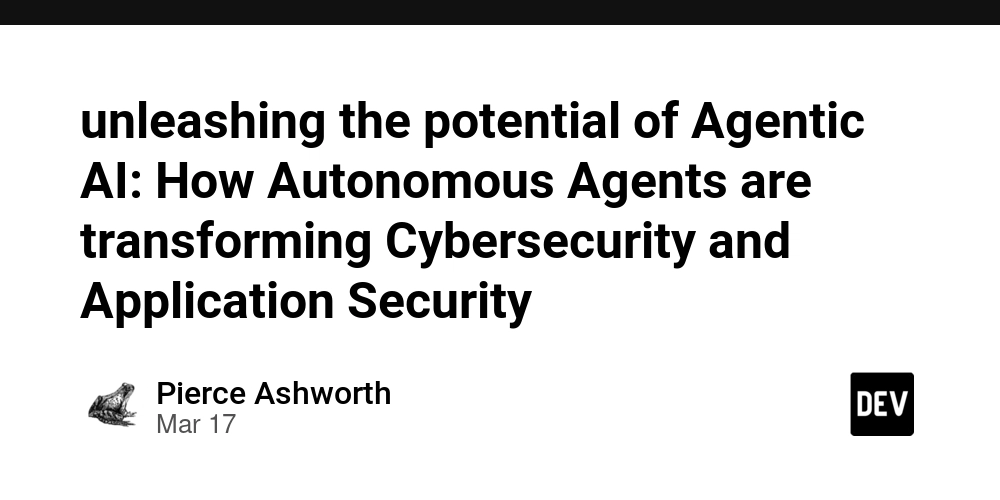unleashing the potential of Agentic AI: How Autonomous Agents are transforming Cybersecurity and Application Security
Here is a quick outline of the subject: Artificial intelligence (AI), in the constantly evolving landscape of cyber security has been utilized by organizations to strengthen their security. Since threats are becoming increasingly complex, security professionals tend to turn to AI. AI was a staple of cybersecurity for a long time. been an integral part of cybersecurity is now being re-imagined as agentsic AI, which offers an adaptive, proactive and context aware security. The article focuses on the potential for agentsic AI to improve security with a focus on the application of AppSec and AI-powered automated vulnerability fixes. The rise of Agentic AI in Cybersecurity Agentic AI refers to autonomous, goal-oriented systems that understand their environment, make decisions, and implement actions in order to reach particular goals. Agentic AI differs from the traditional rule-based or reactive AI because it is able to adjust and learn to its surroundings, as well as operate independently. This independence is evident in AI agents for cybersecurity who have the ability to constantly monitor the network and find anomalies. Additionally, they can react in real-time to threats and threats without the interference of humans. Agentic AI has immense potential in the field of cybersecurity. Intelligent agents are able discern patterns and correlations using machine learning algorithms along with large volumes of data. They can sift through the chaos of many security threats, picking out those that are most important and providing actionable insights for quick intervention. Agentic AI systems have the ability to improve and learn their capabilities of detecting dangers, and adapting themselves to cybercriminals and their ever-changing tactics. Agentic AI as well as Application Security While agentic AI has broad uses across many aspects of cybersecurity, the impact on security for applications is noteworthy. The security of apps is paramount in organizations that are dependent ever more heavily on highly interconnected and complex software systems. The traditional AppSec approaches, such as manual code reviews or periodic vulnerability scans, often struggle to keep up with the rapidly-growing development cycle and threat surface that modern software applications. In the realm of agentic AI, you can enter. By integrating intelligent agents into the software development lifecycle (SDLC) organisations can transform their AppSec processes from reactive to proactive. These AI-powered agents can continuously check code repositories, and examine every code change for vulnerability or security weaknesses. They employ sophisticated methods like static code analysis, automated testing, and machine learning to identify various issues that range from simple coding errors to subtle injection vulnerabilities. The thing that sets agentsic AI apart in the AppSec sector is its ability to comprehend and adjust to the specific situation of every app. In the process of creating a full data property graph (CPG) - a rich representation of the source code that shows the relationships among various components of code - agentsic AI is able to gain a thorough comprehension of an application's structure, data flows, and attack pathways. This contextual awareness allows the AI to identify security holes based on their impacts and potential for exploitability rather than relying on generic severity scores. AI-Powered Automated Fixing: The Power of AI Automatedly fixing weaknesses is possibly one of the greatest applications for AI agent within AppSec. Human developers have traditionally been accountable for reviewing manually code in order to find the vulnerabilities, learn about it and then apply fixing it. The process is time-consuming, error-prone, and often can lead to delays in the implementation of important security patches. It's a new game with agentic AI. AI agents can find and correct vulnerabilities in a matter of minutes through the use of CPG's vast knowledge of codebase. They can analyse all the relevant code to understand its intended function and create a solution that fixes the flaw while being careful not to introduce any additional vulnerabilities. AI-powered automated fixing has profound effects. It is able to significantly reduce the time between vulnerability discovery and resolution, thereby cutting down the opportunity for cybercriminals. This can ease the load for development teams so that they can concentrate on developing new features, rather and wasting their time solving security vulnerabilities. Automating the process of fixing weaknesses can help organizations ensure they are using a reliable and consistent method and reduces the possibility for oversight and human error. What are the obstacles and considerations? The potential for agentic AI in cybersecurity as well as AppSec is enormous however, it is vital to be aware of the risks and concerns that accompany its use. A major concern is

Here is a quick outline of the subject:
Artificial intelligence (AI), in the constantly evolving landscape of cyber security has been utilized by organizations to strengthen their security. Since threats are becoming increasingly complex, security professionals tend to turn to AI. AI was a staple of cybersecurity for a long time. been an integral part of cybersecurity is now being re-imagined as agentsic AI, which offers an adaptive, proactive and context aware security. The article focuses on the potential for agentsic AI to improve security with a focus on the application of AppSec and AI-powered automated vulnerability fixes.
The rise of Agentic AI in Cybersecurity
Agentic AI refers to autonomous, goal-oriented systems that understand their environment, make decisions, and implement actions in order to reach particular goals. Agentic AI differs from the traditional rule-based or reactive AI because it is able to adjust and learn to its surroundings, as well as operate independently. This independence is evident in AI agents for cybersecurity who have the ability to constantly monitor the network and find anomalies. Additionally, they can react in real-time to threats and threats without the interference of humans.
Agentic AI has immense potential in the field of cybersecurity. Intelligent agents are able discern patterns and correlations using machine learning algorithms along with large volumes of data. They can sift through the chaos of many security threats, picking out those that are most important and providing actionable insights for quick intervention. Agentic AI systems have the ability to improve and learn their capabilities of detecting dangers, and adapting themselves to cybercriminals and their ever-changing tactics.
Agentic AI as well as Application Security
While agentic AI has broad uses across many aspects of cybersecurity, the impact on security for applications is noteworthy. The security of apps is paramount in organizations that are dependent ever more heavily on highly interconnected and complex software systems. The traditional AppSec approaches, such as manual code reviews or periodic vulnerability scans, often struggle to keep up with the rapidly-growing development cycle and threat surface that modern software applications.
In the realm of agentic AI, you can enter. By integrating intelligent agents into the software development lifecycle (SDLC) organisations can transform their AppSec processes from reactive to proactive. These AI-powered agents can continuously check code repositories, and examine every code change for vulnerability or security weaknesses. They employ sophisticated methods like static code analysis, automated testing, and machine learning to identify various issues that range from simple coding errors to subtle injection vulnerabilities.
The thing that sets agentsic AI apart in the AppSec sector is its ability to comprehend and adjust to the specific situation of every app. In the process of creating a full data property graph (CPG) - a rich representation of the source code that shows the relationships among various components of code - agentsic AI is able to gain a thorough comprehension of an application's structure, data flows, and attack pathways. This contextual awareness allows the AI to identify security holes based on their impacts and potential for exploitability rather than relying on generic severity scores.
AI-Powered Automated Fixing: The Power of AI
Automatedly fixing weaknesses is possibly one of the greatest applications for AI agent within AppSec. Human developers have traditionally been accountable for reviewing manually code in order to find the vulnerabilities, learn about it and then apply fixing it. The process is time-consuming, error-prone, and often can lead to delays in the implementation of important security patches.
It's a new game with agentic AI. AI agents can find and correct vulnerabilities in a matter of minutes through the use of CPG's vast knowledge of codebase. They can analyse all the relevant code to understand its intended function and create a solution that fixes the flaw while being careful not to introduce any additional vulnerabilities.
AI-powered automated fixing has profound effects. It is able to significantly reduce the time between vulnerability discovery and resolution, thereby cutting down the opportunity for cybercriminals. This can ease the load for development teams so that they can concentrate on developing new features, rather and wasting their time solving security vulnerabilities. Automating the process of fixing weaknesses can help organizations ensure they are using a reliable and consistent method and reduces the possibility for oversight and human error.
What are the obstacles and considerations?
The potential for agentic AI in cybersecurity as well as AppSec is enormous however, it is vital to be aware of the risks and concerns that accompany its use. A major concern is the issue of transparency and trust. As AI agents get more self-sufficient and capable of taking decisions and making actions in their own way, organisations must establish clear guidelines and oversight mechanisms to ensure that the AI is operating within the boundaries of behavior that is acceptable. It is crucial to put in place solid testing and validation procedures so that you can ensure the quality and security of AI created solutions.
Another challenge lies in the threat of attacks against AI systems themselves. The attackers may attempt to alter the data, or attack AI model weaknesses since agentic AI techniques are more widespread in cyber security. It is crucial to implement security-conscious AI practices such as adversarial learning as well as model hardening.
The completeness and accuracy of the diagram of code properties is a key element to the effectiveness of AppSec's AI. In order to build and keep an precise CPG You will have to invest in devices like static analysis, testing frameworks, and integration pipelines. Organizations must also ensure that they are ensuring that their CPGs correspond to the modifications that take place in their codebases, as well as the changing threat environment.
The future of Agentic AI in Cybersecurity
However, despite the hurdles however, the future of cyber security AI is positive. As AI techniques continue to evolve it is possible to be able to see more advanced and efficient autonomous agents capable of detecting, responding to and counter cyber attacks with incredible speed and precision. Within the field of AppSec, agentic AI has the potential to change how we create and protect software. It will allow enterprises to develop more powerful reliable, secure, and resilient applications.
In addition, the integration of artificial intelligence into the broader cybersecurity ecosystem opens up exciting possibilities of collaboration and coordination between different security processes and tools. Imagine a world where agents are autonomous and work in the areas of network monitoring, incident reaction as well as threat intelligence and vulnerability management. They would share insights as well as coordinate their actions and provide proactive cyber defense.
As we move forward, it is crucial for organizations to embrace the potential of AI agent while paying attention to the ethical and societal implications of autonomous systems. Through fostering a culture that promotes responsible AI creation, transparency and accountability, we can use the power of AI for a more secure and resilient digital future.
Conclusion
Agentic AI is an exciting advancement in the field of cybersecurity. link here represents a new approach to discover, detect, and mitigate cyber threats. Utilizing the potential of autonomous agents, specifically when it comes to app security, and automated vulnerability fixing, organizations can change their security strategy from reactive to proactive from manual to automated, as well as from general to context conscious.
While challenges remain, agents' potential advantages AI can't be ignored. not consider. In the process of pushing the boundaries of AI in cybersecurity It is crucial to take this technology into consideration with an attitude of continual learning, adaptation, and accountable innovation. This will allow us to unlock the power of artificial intelligence to secure digital assets and organizations.link here











































































































































































![[The AI Show Episode 142]: ChatGPT’s New Image Generator, Studio Ghibli Craze and Backlash, Gemini 2.5, OpenAI Academy, 4o Updates, Vibe Marketing & xAI Acquires X](https://www.marketingaiinstitute.com/hubfs/ep%20142%20cover.png)




























































































































![[DEALS] The Premium Learn to Code Certification Bundle (97% off) & Other Deals Up To 98% Off – Offers End Soon!](https://www.javacodegeeks.com/wp-content/uploads/2012/12/jcg-logo.jpg)


![From drop-out to software architect with Jason Lengstorf [Podcast #167]](https://cdn.hashnode.com/res/hashnode/image/upload/v1743796461357/f3d19cd7-e6f5-4d7c-8bfc-eb974bc8da68.png?#)








































































































.png?#)

































_Christophe_Coat_Alamy.jpg?#)
 (1).webp?#)





































































































![Apple Considers Delaying Smart Home Hub Until 2026 [Gurman]](https://www.iclarified.com/images/news/96946/96946/96946-640.jpg)
![iPhone 17 Pro Won't Feature Two-Toned Back [Gurman]](https://www.iclarified.com/images/news/96944/96944/96944-640.jpg)
![Tariffs Threaten Apple's $999 iPhone Price Point in the U.S. [Gurman]](https://www.iclarified.com/images/news/96943/96943/96943-640.jpg)




































































































































